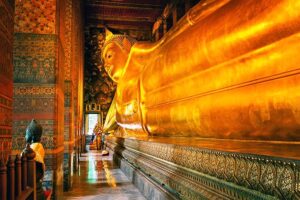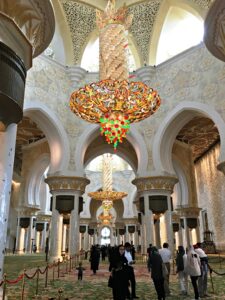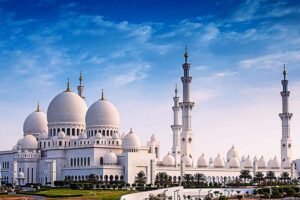» posted on Saturday, August 6th, 2022 by Linda Lou Burton
Old Time Religion
Originally published August 5, 2020 by Linda Lou Burton posting about Abu Dhabi, United Arab Emirates from Little Rock, Arkansas – Today is moving day – I leave Bangkok to go to Abu Dhabi, capital of United Arab Emirates. My 3,100-mile Ethiad Airlines flight takes me over the tip of Myanmar, the Bay of Bengal, the widest part of India, and the Arabian Sea before a plane change in Muscat, Oman’s capital city.  I arrive at the Abu Dhabi International Airport (AUH) at 3:05 and head for the Marriott St Regis where my room overlooks the Persian Gulf. And I exchange a view of golden stupas for white domed mosques. It was an adjustment coming to Bangkok, a city where there are more people per square mile than I’ve ever experienced, but I had friends from Thailand; I knew the people, and loved the food, even if I didn’t speak the language. I have never met a single person from the UAE; I don’t know the language, and I have no idea as to what to expect in this Middle Eastern country. That is why I chose to visit. I have a lot to learn. Where to start?
I arrive at the Abu Dhabi International Airport (AUH) at 3:05 and head for the Marriott St Regis where my room overlooks the Persian Gulf. And I exchange a view of golden stupas for white domed mosques. It was an adjustment coming to Bangkok, a city where there are more people per square mile than I’ve ever experienced, but I had friends from Thailand; I knew the people, and loved the food, even if I didn’t speak the language. I have never met a single person from the UAE; I don’t know the language, and I have no idea as to what to expect in this Middle Eastern country. That is why I chose to visit. I have a lot to learn. Where to start?
Waking up this morning in Bangkok, a city filled with Buddhist temples (wats) and going to sleep tonight in Abu Dhabi, a city filled with Islamic mosques, got me thinking about religion. Religions need “places to worship and practice,” hence, belief systems impact architecture; and so, it follows, the “look” of a country. I already understand the basic design features and symbols standard to Christian churches and cathedrals. But I don’t know why wats and mosques look the way they do. So I read about them; listen up.
Architecture of a Wat
The Sangkhawat contains the monks’ living quarters and lies within the wall surrounding the temple compound. The Phutthawat is the area dedicated to Buddha and contains several buildings.
 Ho rakhang, a bell tower used for waking the monks and announcing morning and evening ceremonies
Ho rakhang, a bell tower used for waking the monks and announcing morning and evening ceremonies- Chedi or Stupa in the form of a bell-shaped tower covered with gold leaf, containing a relic chamber
- Ubosot or Bot, the ordination hall and most sacred area
- Wihan, a shrine hall that contains the principal Buddha images and where monks and laypeople congregate
- Sala kan parian, a large, open hall where laity can hear sermons or receive religious education, also used for chanting afternoon prayers
- Sala, an open pavilion providing shade and a place to rest
- Phra rabiang, a peristyle built around the sacred inner area as a cloister
- Ho trai, the temple library or sacred scriptures depository
- Ancillary buildings such as a school
Certain symbols allude to different aspects of the Buddhist religion. One is the four-armed figure of Vishnu; another is the Naga, deities which may appear as a snake, dragon or cobra.
The Wat Pho in Bangkok
 Wat Pho is one of the largest wats in Bangkok. covering over 860,000 square feet. It is home to more than one thousand Buddha images, as well as one of the largest, the Reclining Buddha, 151 feet in length. The perimeter wall has sixteen gates, two of which serve as entrances for the public. The grounds contain four great chedis, 91 small chedis, two belfries, a bot (central shrine), a number of viharas (halls) and various buildings such as pavilions, as well as gardens and a small temple museum. Wat Pho is also a place of education for the general public. A pictorial encyclopedia engraved on granite slabs covers eight subject areas: history, medicine, health, custom, literature, proverbs, lexicography, and the Buddhist religion.
Wat Pho is one of the largest wats in Bangkok. covering over 860,000 square feet. It is home to more than one thousand Buddha images, as well as one of the largest, the Reclining Buddha, 151 feet in length. The perimeter wall has sixteen gates, two of which serve as entrances for the public. The grounds contain four great chedis, 91 small chedis, two belfries, a bot (central shrine), a number of viharas (halls) and various buildings such as pavilions, as well as gardens and a small temple museum. Wat Pho is also a place of education for the general public. A pictorial encyclopedia engraved on granite slabs covers eight subject areas: history, medicine, health, custom, literature, proverbs, lexicography, and the Buddhist religion.
Architecture of a Mosque
Most mosques feature one or more domes, called qubba. Because it is the directional focus of prayer, the qibla wall is often the most ornately decorated area of a mosque.
 Minaret, a tall, slender tower at corners of the mosque, worshippers are called to prayer from here, it is often the highest point in the area
Minaret, a tall, slender tower at corners of the mosque, worshippers are called to prayer from here, it is often the highest point in the area- Mehrab, a semicircular niche in the wall of a mosque that indicates the direction of the Kaaba in Mecca, the direction that Muslims should face when praying
- Domes above the main prayer hall, signifying the vaults of the heaven and sky
- Prayer hall, with no chairs or pews so as many worshipers as possible can line the room
- Raised areas from which daily prayers are led, or sermons delivered
- Ablution areas where Muslims wash hands, forearm, face and feet before they pray
- Additional facilities from health clinics to libraries to gymnasiums, to serve the community
Certain symbols allude to different aspects of the Islamic religion. One of these is the spiral in reference to heaven as it has “no beginning and no end.” Mosques often have floral patterns or images of fruit and vegetables, allusions to paradise after death.
The Grand Mosque in Abu Dhabi
 The Grand Mosque in Abu Dhabi is the largest in the country, accommodating over 40,000 worshippers; the main prayer hall can hold over 7,000. There are two smaller prayer halls, with a capacity of 1,500 each, one of which is the women’s prayer hall. Minarets on the four corners of the courtyard are 351 feet in height. The courtyard is 180,000 square feet; its floral design is considered to be the largest example of marble mosaic in the world. The carpet in the main prayer hall measures 60,570 square feet, weighs 35 tons, and was made by 1,300 carpet knotters. The pools along the arcades reflect the mosque’s columns, which are illuminated at night; the lighting system reflects the phases of the moon. The 96 columns in the main prayer hall are marble clad and inlaid with mother of pearl. The 99 qualities or attributes of God (Allah) are featured on the qibla wall in traditional Kufic calligraphy.
The Grand Mosque in Abu Dhabi is the largest in the country, accommodating over 40,000 worshippers; the main prayer hall can hold over 7,000. There are two smaller prayer halls, with a capacity of 1,500 each, one of which is the women’s prayer hall. Minarets on the four corners of the courtyard are 351 feet in height. The courtyard is 180,000 square feet; its floral design is considered to be the largest example of marble mosaic in the world. The carpet in the main prayer hall measures 60,570 square feet, weighs 35 tons, and was made by 1,300 carpet knotters. The pools along the arcades reflect the mosque’s columns, which are illuminated at night; the lighting system reflects the phases of the moon. The 96 columns in the main prayer hall are marble clad and inlaid with mother of pearl. The 99 qualities or attributes of God (Allah) are featured on the qibla wall in traditional Kufic calligraphy.
It seems there’s not much difference in wats and mosques, when you think about what they mean to the people who built them.
